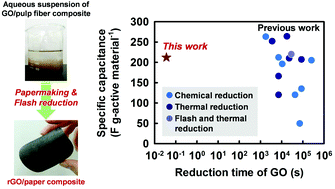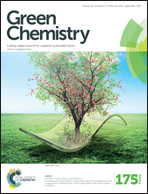Fast, scalable, and eco-friendly fabrication of an energy storage paper electrode†
Abstract
Recent progress in portable and wearable electronics has promoted a growing demand for high-performance and flexible energy-storage devices that are abundant and affordable. Because reduced graphene oxide (rGO), originating from inexpensive graphite, serves as a higher-performance energy-storage electrode than conventional activated carbons and carbon nanotubes, research and development of rGO/polymer composite electrodes for flexible supercapacitors have become a center of attraction. However, the fabrication of rGO-based flexible electrodes frequently requires a long time with high-temperature treatment or toxic chemical treatment, resulting in the lack of scalability and eco-friendliness. Here we show a fast, scalable, and environment-compatible route to fabricate a high-performance rGO/cellulose paper supercapacitor electrode. Single-layer graphene oxide (GO) sheets and recycled waste pulp fibers were successfully fabricated into a paper composite by a well-established scalable papermaking process, followed by a room-temperature, additive-free, and millisecond-timescale flash reduction process. The as-prepared rGO/paper electrode had a high specific capacitance, up to 212 F g−1, for an all paper-based flexible supercapacitor, comparable to those of state-of-the-art rGO-based electrodes, while dramatically decreasing the reduction time of GO from the conventional hour timescale to milliseconds. This work will pave the way for green, flexible, and mass-producible energy-storage paper in future wearable electronics.


 Please wait while we load your content...
Please wait while we load your content...